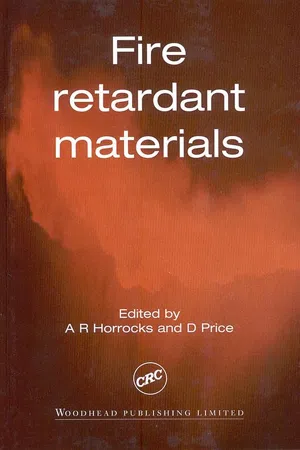
- 448 pages
- English
- ePUB (mobile friendly)
- Available on iOS & Android
Fire Retardant Materials
About this book
This is a comprehensive source of information on all aspects of fire retardancy. Particluar emphasis is placed on the burning behaviour and flame retarding properties of polymeric materials and textiles. It covers combustion, flame retardants, smoke and toxic products generally and then goes on to concentrate on some more material-specific aspects of combustion in relation to textiles, composites and bulk polymers. Developments in all areas of fire retardant materials are covered including research in new areas such as nanocomposition.Fire retardant materials is an essential reference source for all those working with, researching into, or designing new fire retardant materials.- Detailed analysis of the burning behaviour and flame retarding properties of ploymers, composites and textiles- Covers smoke and toxic gas generation- Analysis of material performance in fire
Frequently asked questions
- Essential is ideal for learners and professionals who enjoy exploring a wide range of subjects. Access the Essential Library with 800,000+ trusted titles and best-sellers across business, personal growth, and the humanities. Includes unlimited reading time and Standard Read Aloud voice.
- Complete: Perfect for advanced learners and researchers needing full, unrestricted access. Unlock 1.4M+ books across hundreds of subjects, including academic and specialized titles. The Complete Plan also includes advanced features like Premium Read Aloud and Research Assistant.
Please note we cannot support devices running on iOS 13 and Android 7 or earlier. Learn more about using the app.
Information
Introduction: polymer combustion, condensed phase pyrolysis and smoke formation
1.1 Polymers
1.1.1 Classification of polymers
1.1.2 Chemical classes of polymers
Table of contents
- Cover image
- Title page
- Table of Contents
- Copyright page
- Preface
- List of contributors
- 1: Introduction: polymer combustion, condensed phase pyrolysis and smoke formation
- 2: Mechanisms and modes of action in flame retardancy of polymers
- 3: Toxicity of fire retardants in relation to life safety and environmental hazards
- 4: Textiles
- 5: Composites
- 6: Nanocomposites
- 7: Recent developments in flame-retarding thermoplastics and thermosets
- 8: Applications of halogen flame retardants
- 9: Natural polymers, wood and lignocellulosic materials
- 10: Intumescent materials
- 11: Graft copolymerisation as a tool for flame retardancy
- 12: Performance-based test methods for material flammability
- 13: Fire safety design requirements of flame-retarded materials
- 14: Mathematical modelling
- Index